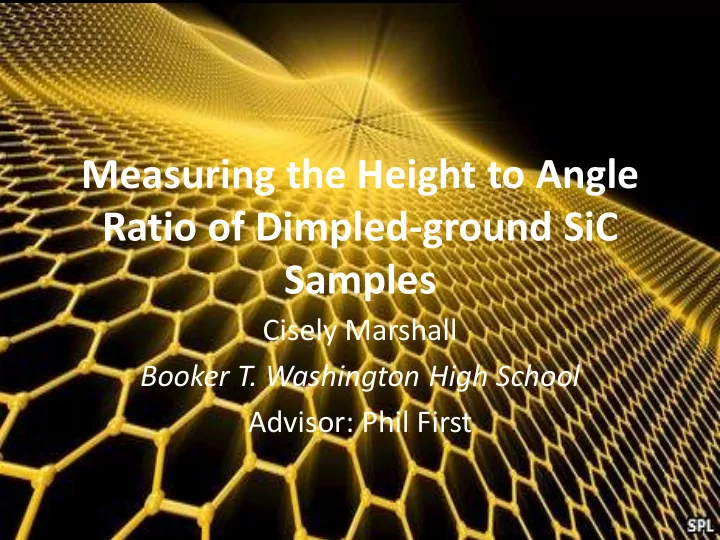

Measuring the Height to Angle Ratio of Dimpled-ground SiC Samples Cisely Marshall Booker T. Washington High School Advisor: Phil First
Problem • Will height to ratio measure of a dated sample of SiC (silicon carbide) differ from its original measurements?
Background • A detailed understanding of silicon carbide surfaces is of great importance for both fundamental SiC growth experiments as well as for technological applications • Growth of epitaxial graphene on SiC has been shown to begin at step edges. • Control of the step-edge density and step bunching on the substrate is important for the production of large-area and high-quality graphene.
Research Objective • The objective is to investigate the morphological and structural changes of a SiC sample that may have undergone oxidation.
Methodology • Silicon Carbide samples were cleaned and prepared for etching. • SiC sample was dimpled before etching • Atomic Force Microscopy (AFM) was used to view the surface before processing. • The samples were etched in the FirstNano Graphene Furnace in the Marcus clean room. • AFM was repeated for morphological imaging
Results • (a) Focuses on the rim of the depression. On the left, 1.5 nm high steps are observed with an average step distance of about 25nm. • Moving over the edge further into the concave-shaped surface, the polar misorientation and consequently the step density increases as can be seen in (b). • Further towards the center of the depression, regular and straight steps are observed (c) – (e). • Near the center of the concave-shaped surface (d), the step density is extremely low and 0.75 nm steps are found.
Conclusion • It is suggested that from the AFM imagery that there was not a significant change in the height to angle ratio of the dated SiC sample as compared to its original production date.
Using Graphene to Conduct Electricity Cisely Marshall Step-Up Fellowship Lesson Plan
Standards • Next Generation Science Standards – HS-PS3-3. Design, build, and refine a device that works within given constraints to convert one form of energy into another form of energy. • Georgia Performance Standards – SP5. Students will evaluate relationships between electrical and magnetic forces. – a. Describe the transformation of mechanical energy into electrical energy and the transmission of electrical energy. – b. Determine the relationship among potential difference, current, and resistance in a direct current circuit.
Resources • Student Reference Sheet • Student Worksheet • Student Team Materials – Pencils – Paper – LED lights – 330 Ohm resistors – Insulated connectors – 9V batteries
Essential Questions • What are the physical properties of graphene that makes it an ideal conductor or insulator? • What are potential benefits of graphene and its impact of electrical technology?
Objectives • Students will learn about nanotechnology and how engineers can harness the differences in how materials behave when small, to address challenges in many industries. • Students will learn how to build and run an electrical circuit. • Students will learn to measure current and voltage anywhere in the circuit. • Students will determine the relationships between Current, Voltage and Resistance.
Sponge/Warm-Up • Based on the reading material ( The Power of Graphene) that was given during last class period, what are some potential applications for graphene? • View video – Graphene: The Next Wonder Material?
Anticipatory Setting • Hook (gain students ’ interest) – The 9 Best Nanotechnology-Powered Products • Direct Instruction – Lecture: Powerpoint Presentation Electrical circuits, insulators, and conductors
Work Period • Students will work in teams to create a hypothesis. • Decide whether graphene would be an electrical conductor or insulator. • Write a paragraph to support hypothesis. • Construct a simple circuit (test light bulb) • Adjust circuit so that current flows through graphite layered paper.
Work Period • Observation and Results • Application Development – Based on the results of the experiment, students will prepare a brief presentation about how graphene might improve a product or allow the product to be smaller.
Closing • Group presentations • Reflection
Acknowledgments • Dr. Leyla Conrad • Dr. Phil First • Louis Wu • M. Tien Hoang • Georgia Tech • NSF
Recommend
More recommend